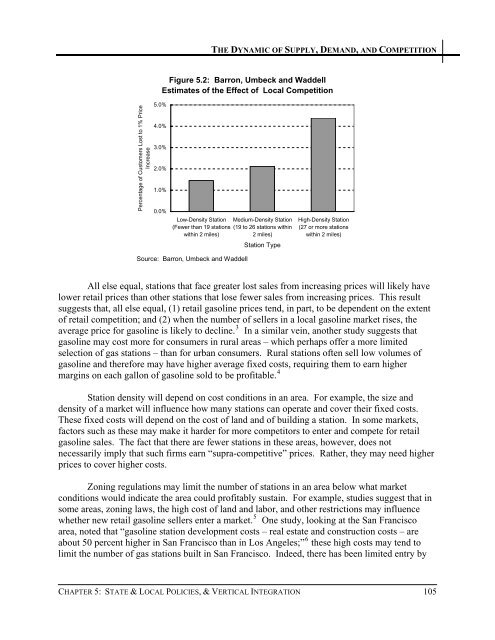Gasoline Price Changes - Federal Trade Commission
Gasoline Price Changes - Federal Trade Commission
Gasoline Price Changes - Federal Trade Commission
You also want an ePaper? Increase the reach of your titles
YUMPU automatically turns print PDFs into web optimized ePapers that Google loves.
Percentage of Customers Lost to 1% <strong>Price</strong><br />
Increase<br />
5.0%<br />
4.0%<br />
3.0%<br />
2.0%<br />
1.0%<br />
0.0%<br />
THE DYNAMIC OF SUPPLY, DEMAND, AND COMPETITION<br />
Figure 5.2: Barron, Umbeck and Waddell<br />
Estimates of the Effect of Local Competition<br />
Low-Density Station Medium-Density Station<br />
(Fewer than 19 stations (19 to 26 stations within<br />
within 2 miles)<br />
2 miles)<br />
Source: Barron, Umbeck and Waddell<br />
Station Type<br />
High-Density Station<br />
(27 or more stations<br />
within 2 miles)<br />
All else equal, stations that face greater lost sales from increasing prices will likely have<br />
lower retail prices than other stations that lose fewer sales from increasing prices. This result<br />
suggests that, all else equal, (1) retail gasoline prices tend, in part, to be dependent on the extent<br />
of retail competition; and (2) when the number of sellers in a local gasoline market rises, the<br />
average price for gasoline is likely to decline. 3 In a similar vein, another study suggests that<br />
gasoline may cost more for consumers in rural areas – which perhaps offer a more limited<br />
selection of gas stations – than for urban consumers. Rural stations often sell low volumes of<br />
gasoline and therefore may have higher average fixed costs, requiring them to earn higher<br />
margins on each gallon of gasoline sold to be profitable. 4<br />
Station density will depend on cost conditions in an area. For example, the size and<br />
density of a market will influence how many stations can operate and cover their fixed costs.<br />
These fixed costs will depend on the cost of land and of building a station. In some markets,<br />
factors such as these may make it harder for more competitors to enter and compete for retail<br />
gasoline sales. The fact that there are fewer stations in these areas, however, does not<br />
necessarily imply that such firms earn “supra-competitive” prices. Rather, they may need higher<br />
prices to cover higher costs.<br />
Zoning regulations may limit the number of stations in an area below what market<br />
conditions would indicate the area could profitably sustain. For example, studies suggest that in<br />
some areas, zoning laws, the high cost of land and labor, and other restrictions may influence<br />
whether new retail gasoline sellers enter a market. 5 One study, looking at the San Francisco<br />
area, noted that “gasoline station development costs – real estate and construction costs – are<br />
about 50 percent higher in San Francisco than in Los Angeles;” 6 these high costs may tend to<br />
limit the number of gas stations built in San Francisco. Indeed, there has been limited entry by<br />
CHAPTER 5: STATE & LOCAL POLICIES, & VERTICAL INTEGRATION 105
















